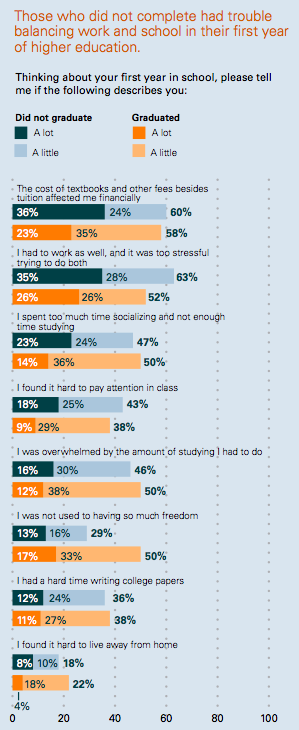“To better your education, you’re always gonna better your status.”
We still rely on myth to fuel the higher education system in this country. We base our policy decisions largely on the perceived truths of yesterday. This Public Agenda report prepared for the Bill & Melinda Gates Foundation shines a glaring light on the reality of college students’ lives in today’s America.
The number one reason for dropping out of school before earning a two or four year college degree is not being able to manage the stress associated with juggling work and school. The majority of these young adults work an average of 20-hours per week while taking on full course loads. Whether it’s because they’re not managing their time properly, or that tuition fees are too high, or perhaps because they weren’t properly prepared for the requirements of studying at a higher education level, the devastating fact is that not many are able to achieve academic success beyond high school. Since cash buys bread and a diploma can only promise the prospect of a better future, schooling takes the brunt of the downfall of today’s society.
“Many of the young people we interviewed believed that they could not afford not to work for the time it would take to complete a degree. They had to have a paying job to make ends meet. Far from being slackers, as some people imagine, they were often assuming responsibilities and financial burdens that traditional full-time college students do not have to shoulder. It is a test of maturity and perseverance that more affluent students are usually not required to face.” ~ Report 1
The report cites that over the last 25 years, college costs have risen by 400 percent while average household income has only climbed 150 percent, painting a undeniable picture of why higher ed isn’t a priority on middle Americans’ minds.
Location of teaching establishment was also cited as a huge obstacle for those who failed to complete their college studies. Many admitted that they found it difficult to access a college close enough to their home or work that offered classes at times that aligned with their work schedules.
“Among those who did not complete college, two-thirds say they selected their school primarily for its convenient location, nearly 6 in 10 because its schedule worked with theirs…”
Reading through the report, I couldn’t help but refer back to my experiences studying and teaching with educational technology. Why aren’t more students considering blended learning options? I understand that students just starting their college careers find the idea of face-to-face time with instructors comforting, which is why I’m not suggesting everyone take a look at fully online degree programs, but what about mixing a bit of online study with the bricks and mortar approach? Is my experience as a borderless student still out of the norm?
But, you know what? Why don’t we set all the fancy research results aside for a moment? I’ll even put my experiences in my pocket and practice opening my mind. Let’s have a listen to what the students had to say for themselves…



 We all know how much students depend on
We all know how much students depend on 